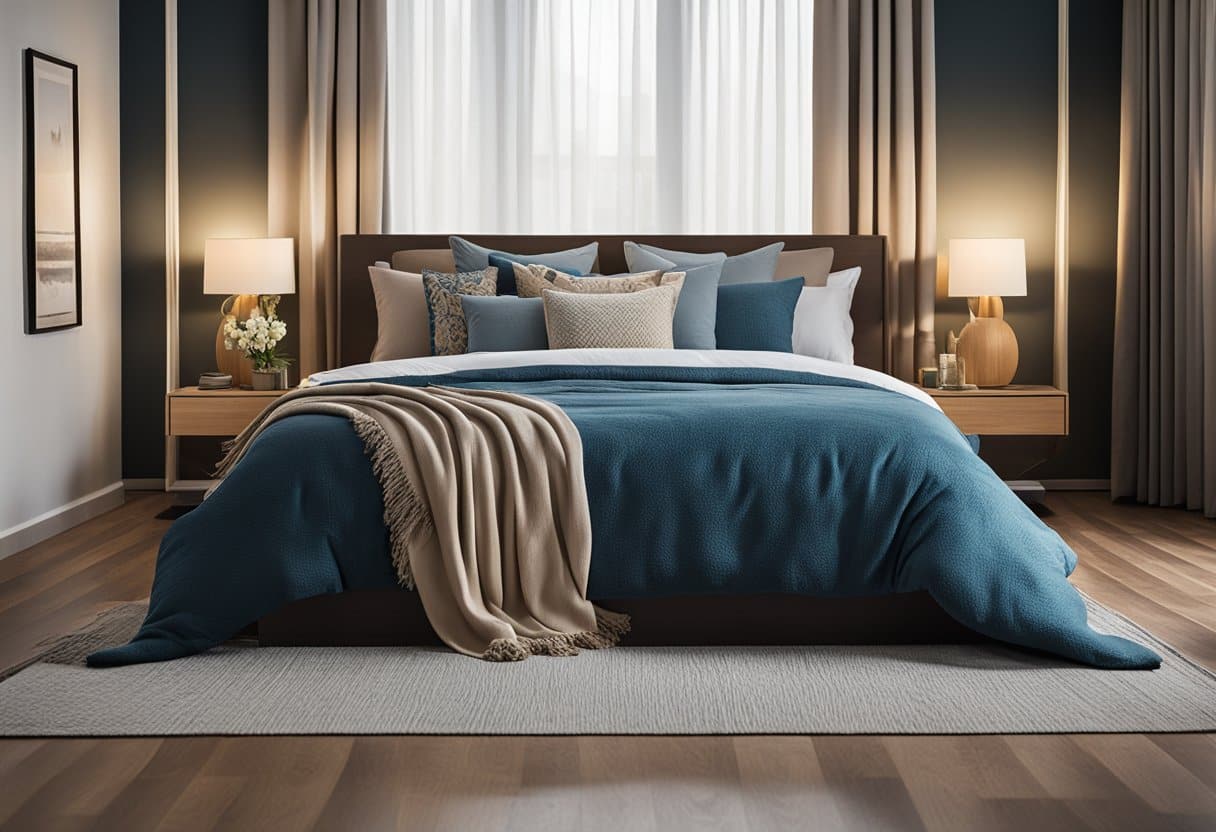
Bedroom Staging Essentials for a Quick Home Sale
Bedroom staging is an essential aspect of interior design, especially when preparing a property for sale. A well-staged bedroom can make a significant difference, potentially increasing a home’s marketability and sale price. It involves arranging furniture, decor, and accessories to highlight the room’s best features, maximize space, and create a welcoming and appealing atmosphere for potential buyers.
The goal of bedroom staging is to create a space that buyers can envision as their own. To achieve this, the room should be presented as neutral and versatile, allowing for personal interpretation. This neutrality is complemented by the strategic use of light and texture, which add depth and interest to the space without overwhelming it with personal style. Thoughtful detailing through accessorization adds just enough character to spark interest while maintaining a universally appealing look.
The Spruce offers a quick 6 tips for bedroom staging.
Key Takeaways
- Proper staging can enhance the appeal and perceived value of a bedroom.
- Neutral color palettes and strategic lighting are key components in bedroom staging.
- Balancing decluttering with tasteful accessorizing helps create an inviting and relatable space.
The Basics of Bedroom Staging
Bedroom staging is a strategic process designed to showcase a bedroom’s best features, improve its aesthetic appeal, and make it more attractive to potential buyers in the real estate market.
Understanding the Staging Concept
Staging a bedroom involves thoughtful preparation of the space to highlight its potential to buyers. This includes decluttering, rearranging furniture, and adding decorative elements that appeal to a broad audience. The goal is to create a space that buyers can envision themselves living in, which often leads to a faster sale and can potentially increase the home’s market value.
Essentials of an Inviting Bedroom
One must focus on its layout and contents to create an inviting bedroom. Furniture should be well-proportioned to the space, ideally showcasing ample room to move around. Here’s a concise list of essentials:
- Bed Placement: Centrally positioned to serve as the focal point.
- Linen Choices: High-quality linens in neutral colors to appeal to a wide range of tastes.
- Accessorizing: Minimal decorative items to add texture and character without overcrowding the space.
- Clutter-Free: The room should be cleared of personal items and unnecessary objects to allow buyers to imagine the space as their own.
The Role of Lighting and Color
Lighting and color choices are crucial in bedroom staging, as they can influence a buyer’s perception of the room’s size and ambiance. Below are strategies for optimizing these elements:
| Aspect | Strategy |
|---|---|
| Light | Maximize natural light with sheer curtains; add strategic lighting to enhance warmth. |
| Color | Stick to neutral colors for walls and large pieces; they serve as a canvas for buyers. |
| Texture | Use various textures in bedding and rugs to add depth without overwhelming with color. |
Proper lighting makes a room feel more spacious and inviting, while a neutral palette creates a serene and adaptable environment.
Furniture and Layout
The arrangement and selection of furniture are fundamental in bedroom staging, as they dictate the room’s aesthetic and functional flow. Furniture choice should complement the bedroom’s size and shape, while placement must create an inviting atmosphere without cluttering the space.
Choosing the Right Bed
The bed, as the centerpiece of any bedroom, should affirm the room’s purpose as a place of rest. Size is paramount – a king-sized bed can serve as a luxurious focal point in a master bedroom, while a queen or full-sized bed may be more practical in smaller rooms. Opt for a high-quality mattress and frame, and dress it with inviting linens to entice potential homeowners. Using a minimalist bed frame or headboard, an organized and simplified approach can draw attention without overwhelming the space.
Strategic Furniture Placement
The placement of other furniture should complement the bed and maintain the room’s balance. For example, dressers and nightstands ought to be accessible but not intrusive. Here’s an optimal arrangement:
- Dresser: Opposite the bed to maintain an unblocked path and to act as a secondary focal point.
- Nightstands: Flanking the bed for symmetry and convenience.
- Additional chairs or benches: Positioned to allow clear walkways while offering extra seating or storage.
Creating a sense of openness can often be achieved by angling furniture pieces slightly, where the room’s dimensions allow. Keeping furniture proportional to the room size is essential to maximize space.
Maximizing Space and Flow
Staging a bedroom involves more than just aesthetics; it’s about illustrating a life free of chaos with plenty of storage and space. To achieve this:
- Use storage wisely: Built-in closets or bed frames with drawers can demonstrate clever storage solutions.
- Declutter: Remove excess items and personal effects to showcase the room’s size and potential for personalization.
Remain mindful of the walking path in the room. There should be a clear, open path to move around the bed and to access windows and wardrobes without hindrances. Furniture should enhance the room’s utility and allure, not obstruct it.
Decluttering and Organizing
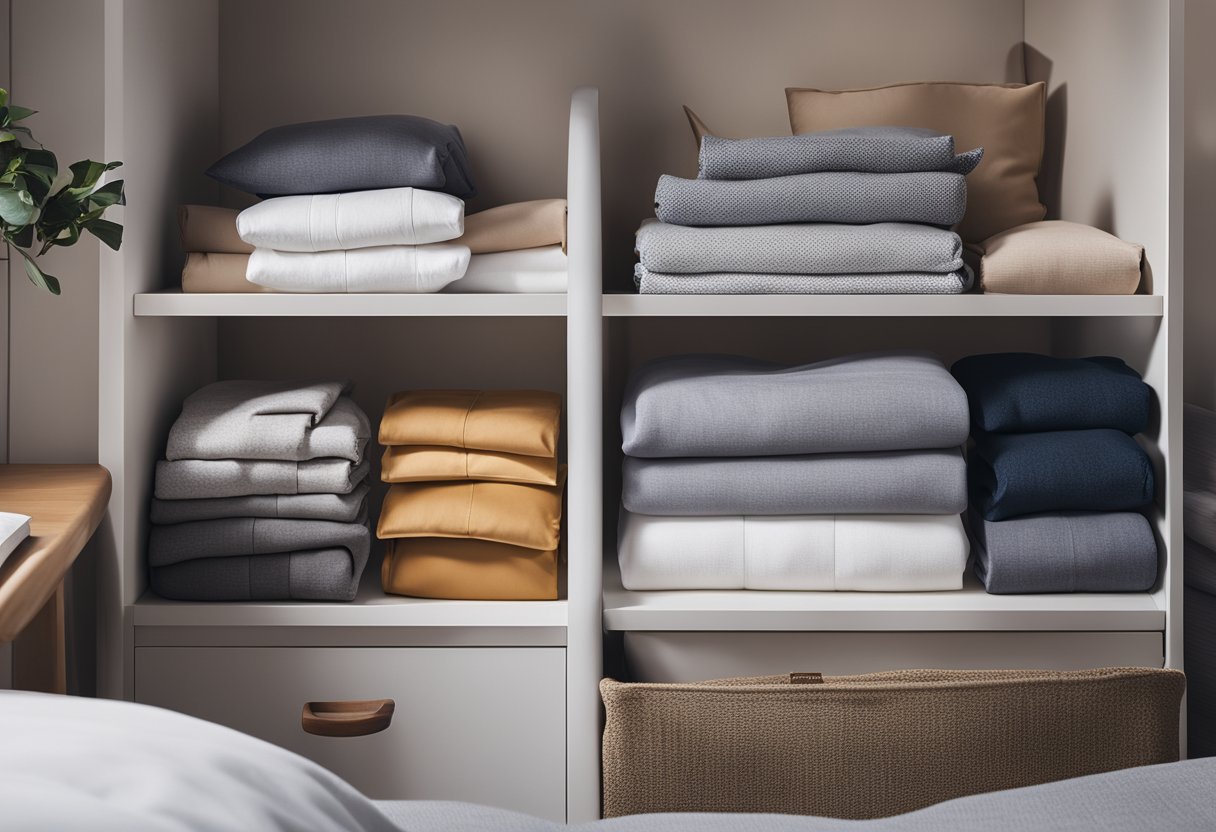
The process of decluttering and organizing a bedroom dramatically enhances its appeal, highlighting spaciousness and tranquility. It involves meticulously reducing clutter, streamlining closet spaces, and keeping surfaces clean and free from unnecessary items.
Clearing the Clutter
To effectively clear clutter, one must first completely empty the room of all non-essential items and then strategically reintroduce only those that serve a purpose or bring joy. This approach echoes the principles of the KonMari method, which emphasizes keeping things that speak to the heart and discarding the rest. It’s crucial to:
- Remove all items that do not belong in the bedroom.
- Sort belongings into categories such as ‘Keep’, ‘Donate’, ‘Recycle’, and ‘Trash’.
- Assess each item based on utility and emotional value.
Closet Organization Tips
Closet organization is paramount in a bedroom’s overall perception of neatness. The National Association of Realtors suggests that an organized closet can be a decisive selling point. To achieve a super-organized closet:
- Use Uniform Hangers: This creates a cohesive look and saves space.
- Implement Storage Solutions: Shelving units, drawers, and bins help categorize items.
| Storage Solution | Function | Example |
|---|---|---|
| Shelving Units | Vertical storage | Stacking sweaters, displaying shoes |
| Drawers | Hidden storage | Stowing away intimates, accessories |
| Bins | Grouping items | Keeping seasonal items, workout gear |
Keeping Surfaces Minimal
Maintaining minimal items on surfaces is key to an organized bedroom. This includes:
- Dresser Tops: Limit items to essentials, like a lamp and a decor piece.
- Nightstands: Keep only must-haves, such as a book or clock, to maintain functionality without overloading space.
Aesthetic Enhancements
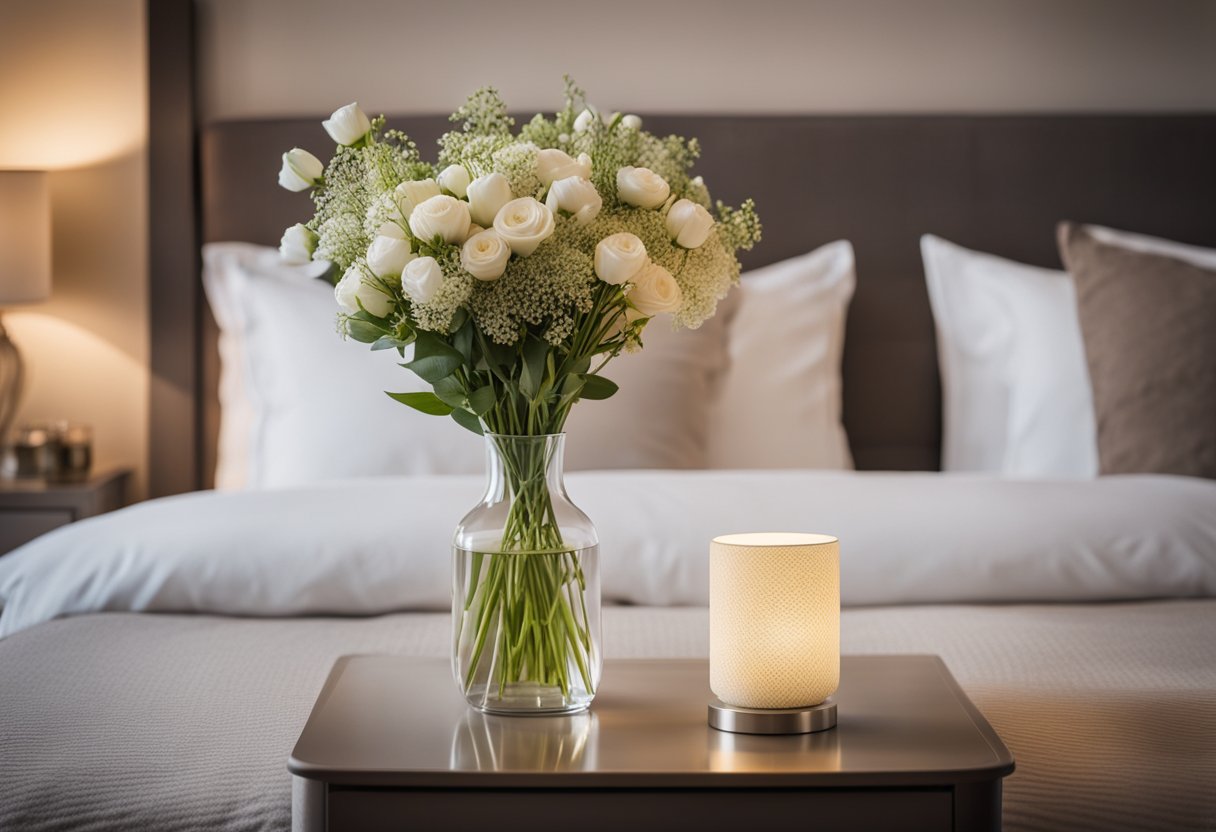
Aesthetic enhancements in bedroom staging involve careful selection and placement of elements that create a welcoming and cohesive look. Texture, color, and light play vital roles in this process, with attention to detail making a significant difference.
Selecting Appropriate Bedding and Linens
Bedding should serve as the bedroom’s focal point, with comfort and style at the forefront. For a unified look, one can opt for a comforter or duvet that complements the room’s color scheme. Pillows add depth; a mixture of large, supportive pillows and smaller, decorative ones in various textures can elevate the overall aesthetic. High-quality linens are also a must; they should feel luxurious and look pristine, encouraging a sense of relaxation and comfort.
Decorative Elements for Atmosphere
The room’s mood is heavily influenced by its decor. Strategic placement of wall art, sculptures, and candles can infuse the space with personality and warmth. Plants are an excellent addition for incorporating natural elements, offering both color and liveliness. When selecting curtains, one should contemplate both functionality and style; they are crucial for privacy and light control, and should also harmonize with the room’s design theme.
Natural and Artificial Lighting
Lighting dictates the ambiance of a bedroom. Windows should be dressed to maximize natural light while maintaining privacy. Semi-sheer curtains are an ideal choice as they soften daylight and add a layer of texture. For the evenings, a combination of overhead lamps and task lighting can create a serene atmosphere. Dimmers are a practical option, allowing control over light intensity. As a final touch, consider the strategic placement of candles or LED lights for a gentle, warm glow.
Creating a Neutral Palette
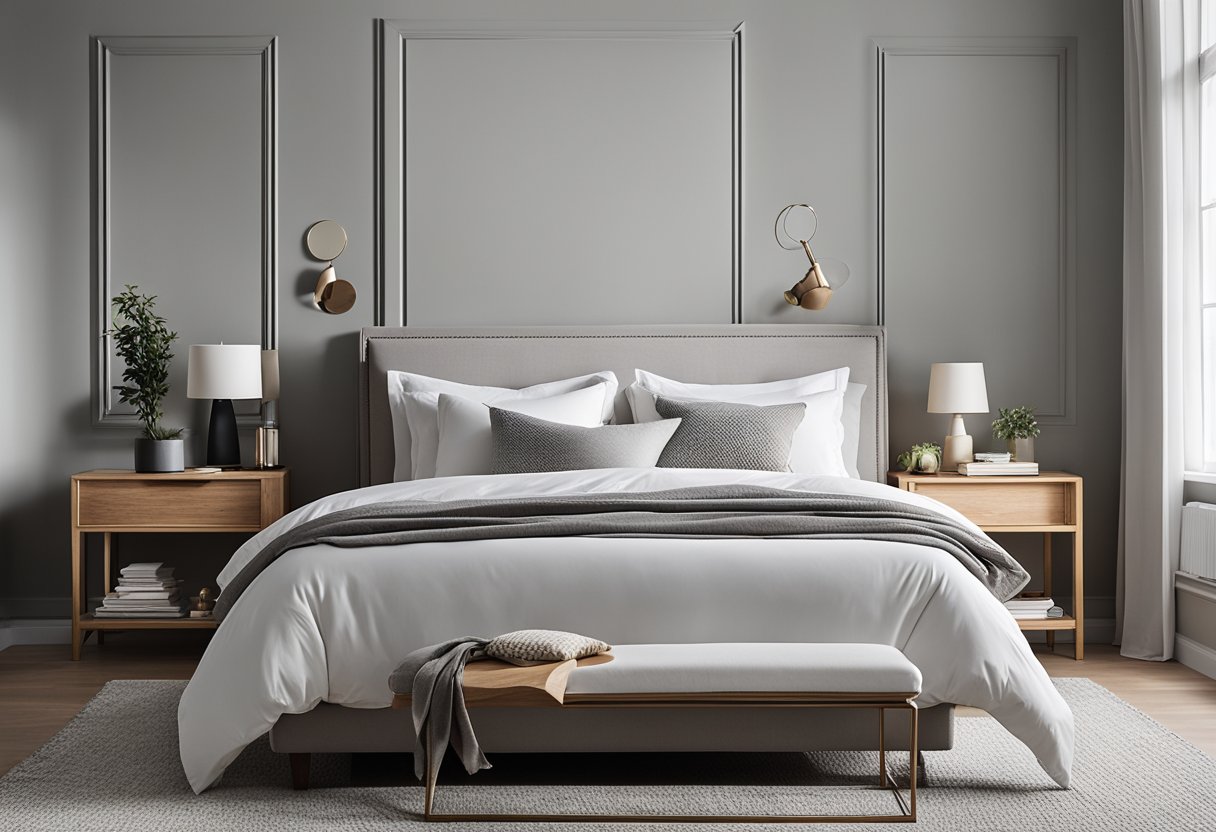
A neutral palette in the bedroom can serve as a calming backdrop and appeal to a wide range of potential homebuyers. It allows for versatility in decor and accentuates a room’s natural light and space.
Paint and Wall Treatments
When selecting paint colors for walls, one should opt for neutral shades like beige, taupe, and soft grays. These colors create a serene environment and complement a variety of furnishing styles.
- Recommended Paint Colors:
- Beige: Provides warmth without overpowering.
- Taupe: A mix of brown and gray, it adds depth to the space.
- Soft Gray: Offers a contemporary look while maintaining a restful ambiance.
In terms of wallpaper, textures or patterns should be subtle to maintain the neutrality of the space. A light, textured wallpaper can add interest without dominating the room.
Bedding and Fabric Choices
For bedding, white linens are a classic choice that evokes cleanliness and simplicity. One could also consider shades like ivory or light gray to maintain the neutral theme. High-quality fabrics with minimal patterns ensure that the bedding complements the neutral walls rather than competes with them.
- Fabric Options:
- Cotton: Breathable and comfortable year-round.
- Linen: Offers a casual, yet elegant aesthetic.
To enhance the color palette, throw pillows and blankets can include a range of grays or neutral patterns. This allows for subtle pops of texture and interest while keeping the overall look cohesive and undistracting.
Accessorizing and Personal Touches
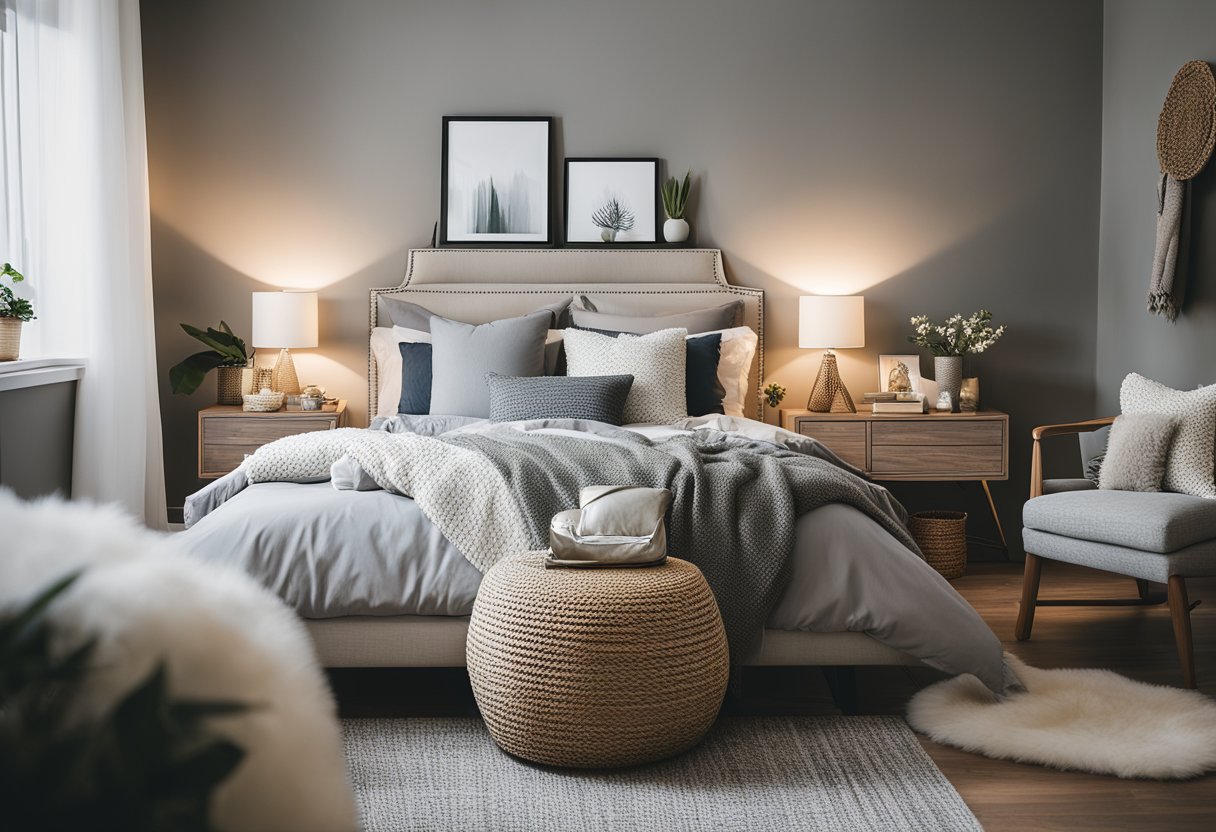
When staging a bedroom, accessories and personal touches can transform a space into a welcoming haven. It’s important to strike a balance; the room should feel lived-in yet uncluttered, with elements that draw the eye and create a cohesive aesthetic.
Integrating Artwork and Mirrors
Artwork can infuse personality into a bedroom. When selecting pieces, one should consider the color scheme and style of the room. Ideally, art should complement the existing decor without overwhelming the space. Mirrors strategically placed can make the room feel larger and more open. For an elegant look, one might choose a large, framed mirror hung above the dresser or a set of smaller mirrors arranged artistically on a feature wall.
Artwork Selections:
- Color Harmony: Choose artwork with colors that harmonize with the bedding and walls.
- Size & Scale: Ensure the size of the artwork is appropriate for the wall it’s on.
Mirror Placement:
- Opposite Windows: To reflect natural light and enhance brightness.
- Above Furniture: For a sense of height and space.
Adding Plants and Flowers
Greenery can bring life to a bedroom, making it feel fresh and vibrant. Live plants promote a relaxing atmosphere; however, if maintenance is a concern, artificial plants offer a durable alternative without sacrificing aesthetics. When incorporating plants, one should consider size and placement to maintain harmony in the room. Small pots on bedside tables or a single large plant in a corner can serve as focal points.
- Plant Ideas:
- Tabletop: Small succulents or fresh flowers in a vase.
- Corner: A taller potted plant to fill an empty space.
Incorporating Sensory Elements
Engaging the senses can give a bedroom an inviting ambiance. The addition of soft textures, such as a plush throw or velvet pillows, adds comfort and warmth. Artificial light, such as lamps with warm bulbs, can create a soothing atmosphere in the evenings. One should be mindful of scents—too strong and they can be overpowering, but a subtle hint of lavender or vanilla can provide a calming presence.
Textures and Comfort:
- Throw Blankets: A folded throw at the end of the bed.
- Pillows: A mix of large and small pillows layered for visual and tactile comfort.
Lighting:
- Bedside Lamps: For reading and a soft glow.
- Dimmable Lights: Adjustable lighting to suit different moods and times of day.
Enhancing Appeal for Buyers
To effectively sell your home, bedroom staging should create a space that resonates with potential buyers, highlighting key features while appealing to a range of preferences.
Emphasizing Unique Features
Bedrooms with unique characteristics can stand out to buyers if staged correctly. For instance, a bedroom with a large bay window can be transformed into a focal point by maximizing natural light, complemented by light, airy curtains. Strategic furniture placement that highlights architectural elements, like a fireplace or built-ins, invites buyers to envision the space as their own.
Staging for Different Demographics
Understanding your target demographics is essential in real estate staging. For younger buyers, a modern and minimalistic approach with technology-friendly features may be appealing. Conversely, older buyers might prefer a more classic, comfortable setting with warm lighting and plush bedding. Ensuring that the bedroom’s decor and setup cater to the preferences of various demographics can broaden the appeal of your home.
Applying the Final Touches
The final touches in staging a bedroom play a crucial role in the selling process. Ensure that the bedroom is not only tidy but also depersonalized, making it easier for buyers to imagine themselves in the space. Adding elements such as fresh linens or a small vase of flowers can enhance the room’s ambiance. Consider incorporating smart, functional storage solutions that demonstrate how the space can be utilized effectively. Refer to insightful tips for turning your master bedroom into the calm oasis every buyer dreams of coming home to, providing practical advice for bedroom staging.
Bedroom Staging Practicalities
Effective bedroom staging balances cost, effort, and time to maximize appeal in a real estate transaction. This section looks at budget-conscious strategies, compares DIY efforts to professional services, and suggests a timeline for staging.
Budget-Friendly Tips
- Decluttering: Remove personal items and excess furniture to create a spacious feel.
- Neutral Paint: A fresh coat of paint in a neutral color appeals to a wider audience.
- Accessorize Wisely: Invest in a few key pieces like quality bedding or a statement art piece to elevate the room without overspending.
- Second-hand Finds: Consider refurbished or second-hand décor items to save costs.
DIY Staging Versus Professional Help
- DIY Staging:
- Pros: Cost-effective; personal control over the process.
- Cons: Time-consuming; may lack the ‘polished’ look of a professional.
- Professional Staging:
- Pros: Experienced eye; potentially faster sale at a higher price.
- Cons: Higher upfront cost; less control over the staging process.
When deciding between DIY and hiring professional stagers, consider the homeowner’s staging skill, the value of their time, and the competitive edge that a professionally staged bedroom might offer.
Timeline and Planning for Staging
- Pre-Staging:
- Define the budget and scope of staging efforts.
- Staging Process:
- Plan for 1-2 weeks for DIY staging or a few days for professional staging.
- Allocate time for repairs and updates, which can vary widely based on the bedroom’s condition.
- Post-Staging:
- Expect to maintain the bedroom’s appearance throughout the listing period.
A clear, well-executed timeline ensures that the staging process complements the overall goals and timeline of the home staging within the broader real estate transaction.
Conclusion
Bedroom staging is a crucial element in the real estate market, enhancing a home’s appeal to potential buyers. By employing strategic placement of furniture and decor, sellers can create an inviting atmosphere that may facilitate a quicker sale. Estate agents often recommend these techniques, as they recognize the powerful impact a well-presented bedroom can have on a buyer’s decision-making process.
Homelight, an online real estate platform, underscores the importance of editorial integrity and the value of an authentic depiction of properties. When staging, it’s essential to balance aesthetic improvement with an honest representation of the space.
Effective Bedroom Staging Tips:
- Declutter: Keep surfaces clean and minimalistic.
- Neutralize: Choose soft, neutral colors for walls and linens.
- Accentuate: Highlight the bedroom’s best features with thoughtful decor.
In conclusion, sellers are advised to approach bedroom staging with a blend of creativity and realism. Staging should aim to showcase the potential of a bedroom space without misrepresenting it. This approach not only aligns with ethical marketing but also sets clear expectations for buyers, ultimately contributing to the integrity and trustworthiness of the real estate industry.
Luxury Specialist at McGraw Realtors
With a diverse background, including a career as an Air Force fighter pilot and entrepreneurship, Bill transitioned to real estate in 1995. Co-founding Paradigm Realty with his wife, Charlene, he quickly rose to prominence in Oklahoma City’s luxury real estate scene. Now, as one of the top agents with annual sales surpassing $20 million, Bill’s dedication to exceptional service remains unparalleled. With a legacy spanning over two decades in the industry, Bill’s expertise and commitment make him a trusted name in luxury real estate.